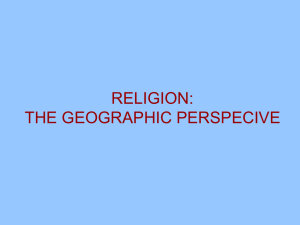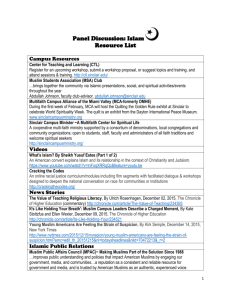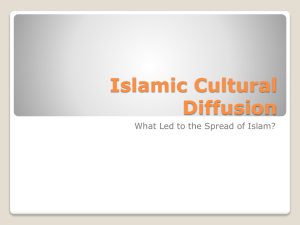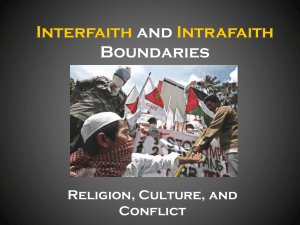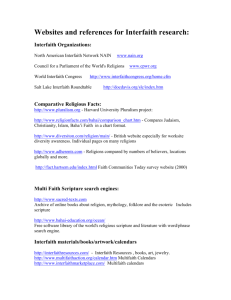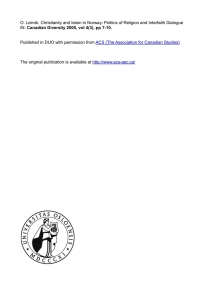AP Human Geography - GonzalesatBerthoud
advertisement
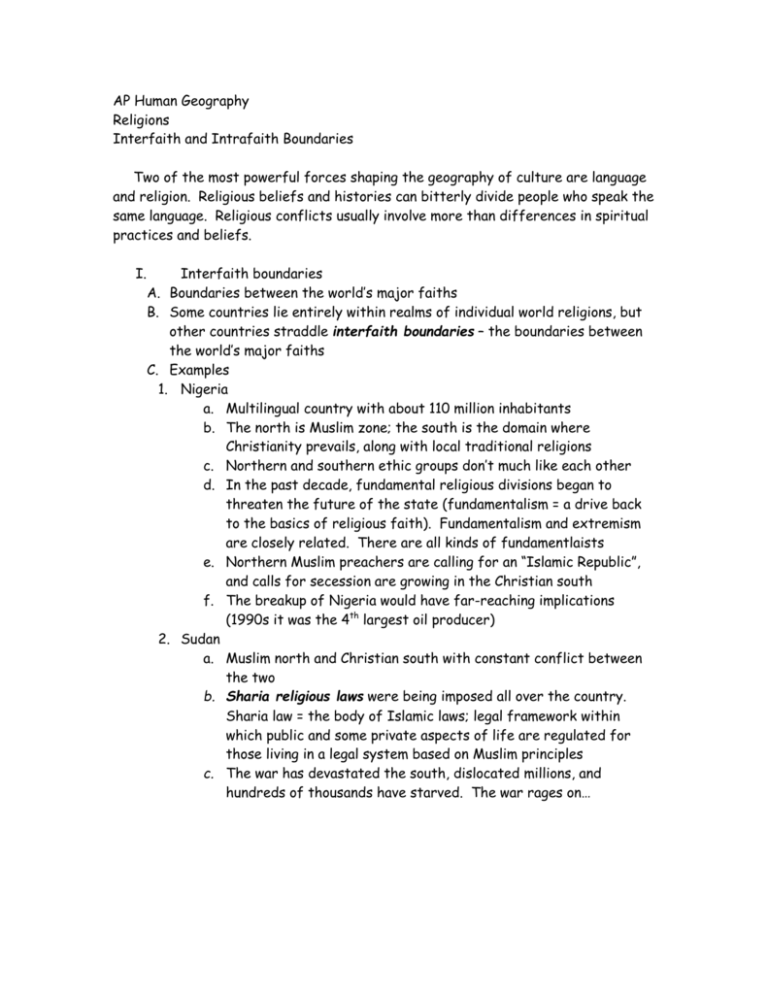
AP Human Geography Religions Interfaith and Intrafaith Boundaries Two of the most powerful forces shaping the geography of culture are language and religion. Religious beliefs and histories can bitterly divide people who speak the same language. Religious conflicts usually involve more than differences in spiritual practices and beliefs. I. Interfaith boundaries A. Boundaries between the world’s major faiths B. Some countries lie entirely within realms of individual world religions, but other countries straddle interfaith boundaries – the boundaries between the world’s major faiths C. Examples 1. Nigeria a. Multilingual country with about 110 million inhabitants b. The north is Muslim zone; the south is the domain where Christianity prevails, along with local traditional religions c. Northern and southern ethic groups don’t much like each other d. In the past decade, fundamental religious divisions began to threaten the future of the state (fundamentalism = a drive back to the basics of religious faith). Fundamentalism and extremism are closely related. There are all kinds of fundamentlaists e. Northern Muslim preachers are calling for an “Islamic Republic”, and calls for secession are growing in the Christian south f. The breakup of Nigeria would have far-reaching implications (1990s it was the 4th largest oil producer) 2. Sudan a. Muslim north and Christian south with constant conflict between the two b. Sharia religious laws were being imposed all over the country. Sharia law = the body of Islamic laws; legal framework within which public and some private aspects of life are regulated for those living in a legal system based on Muslim principles c. The war has devastated the south, dislocated millions, and hundreds of thousands have starved. The war rages on… 3. South Asia a. Part of Britain’s colonial empire which extended from Pakistan in the west to Bangladesh in the east; included Kashmir to Sri Lanka b. This area is astride a divisive interfaith boundary c. 1947 a political boundary was established between Islamic Pakistan and multicultural India – this produced one of the largest human migrations of modern times. Millions of Muslims crossed into Pakistan and Hindus moved into India. d. Sporadic conflict until the 1980s, then more intense conflict 1) The Sikhs campaigned for greater or outright independence a)The Sikhs demanded a separate state in Punjab b)Indian army raided the Sikh’s holiest shrine causing more than 1000 deaths c)India’s prime minister, Indira Gandhi, was assassinated by a Sikh member of her bodyguard e. Late 1980s = second development. Holy shrine claimed by Muslims and Hindus became battleground 1) Muslims regained control of the site 2) Late 1992 mob of Hindu fundamentalists stormed the mosque and destroyed it 3) Early 2002 the mosque was to be rebuilt, but new waves of violence erupted f. Hinduism began to display the sort of fundamentalism and militancy associated with other religions g. The rise in fundamentalism is affecting nearly all religions today 4. The former Soviet Union a. When the Soviet Union was first formed, it had 15 Soviet republics and other territories of lesser rank b. Russia, the largest republic was divided into 70 territories c. The Soviets inherited more than 100 ethnic groups, plus their 1) languages, beliefs, and life ways 2) parts of two great religious realms – Eastern Orthodox Church and Islam d. When the USSR collapsed, Soviet Republics became independent states and ethic strife broke out e. Christian and Muslims fought; Islam revived in central Asian republics f. Kazakhstan poses the most serious problem because IslamicChristian interfaith boundary runs right across the state (Christians in the north, Muslims in the south) 5. The former Yugolslavia II. Intrafaith Boundaries A. It refers to boundaries within a single major faith B. This includes divisions between Christian Protestants and divisions between Muslim Sunni and Shi'ite C. Northern Ireland 1. Biggest problem in Western Europe 2. Catholic and Protestant conflict. 3. Ireland was partitioned by Britain. Conflict over access to opportunities, civil rights, and political influence is the real issue D. Islamic Realm 1. Iran-Iraq conflict in 1980s 2. After the Gulf War, the Sunni-controlled army of defeated Iraq moved against the Shiite communities of the south 3. Current day Iraq

